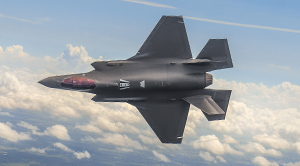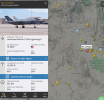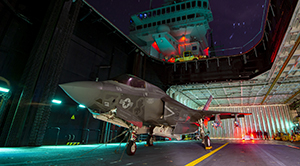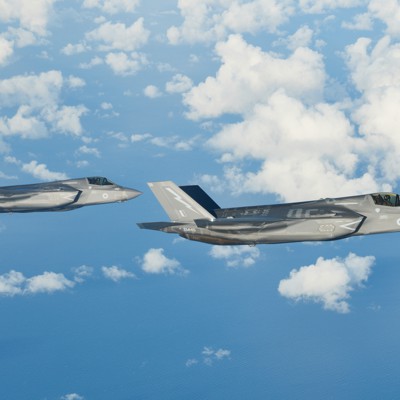The F-35 is a 'Significantly Better Tool'
26 Feb 2021 Andreas Lindqvist, Ingeniøren
"The first F-35 pilot of Denmark has now flown 10 times in the new fighter. He tells how it differs from the 40-year-old F-16.
The first time I met KIN was in 2011 on a beautiful spring day at the Italian island Sicily. I am on a trip to cover a story from the Sigonella air base, from where the Allies are flying to the air war over Libya, which was going to help remove the dictator of the country, Muammar Gadaffi.
The pilot with the flight name KIN - his civil name is confidential - has just landed from one of the long expeditions across the Mediterranean and into the North African country to hit strategic targets with the bunker busts that were among the specialties in Denmark in the war. This is the first time Danish fighter pilots have dropped bombs in war. And there are demands for them – later when the total has been settled, they have thrown almost a thousand, an eighth of the that the alliance has dropped down on Libya.
But it is also an uncomfortable and risky affair for the Danish pilots to fly so far over sea and over the enemy in the single-engine F-16. Therefore, the 'sharp' mission is also a natural place to start when I talk to KIN again 10 years later.
First Dane in F-35
In the meantime, the experienced fighter pilot has become the first Dane to fly the F-35. Currently, he is at Luke Air Force Base in Arizona training to be an instructor for the rest of the Danish pilots.
Now, he has flown 10 trips in the state-of-the-art stealth fighter aircraft, of which Denmark has ordered 27. The first will be in Denmark in 2023. They cost almost half a billion DKK each, and in addition there are equipment, buildings and operating costs, which multiply the bill.
But from a pilot’s point of view, it is worth the money, says KIN. Not least because the F-35 alone can solve many of the tasks of surveillance, electronic warfare and attack which in Libya required various specialized aircraft in the air at the same time.
"Where we were in Libya we had to be supported by many different platforms in order to succeed, fewer F-35s will be able to solve the task without the support of other aircraft. To a large extent we will get self-protection, and object designation will be of a completely different calibre. And the F-35 greatly relieves the pilot with the assurance that we hit the right object, which we then spent a lot of resources on," KIN says.
The 40-year-old F-16 is, despite constant upgrades, about to be an old aircraft. It even lacks the digital navigation map, which is now standard even in semi-cheap cars. And it does not collect the information about, for example, airspace, radar, targets, weapons and other activity for the pilot.
But in the F-35, it all gets fused in a kind of extended tablet interface, where the pilot can set up his 'desk' with 3D cards and instruments and have data sent to his HUD - head-up display - the visor. It reduces work pressure, stress level and the risk of making fatal mistakes.
“In the F-16, for example, I have to call up the information from the targeting pod, decipher it, round it correctly and manually put it into the flight computer. And then double check if these are the right coordinates I have chosen before I bomb them. In another system, I have to pick my weapons and make sure the bombs have the right profiles. At the same time, I have to keep an eye on the radar to see if there are any hostile activities," he explains.
Yet, KIN has not fully got used to the cockpit, although there is more space - he thinks it is a hassle to get settled in the aircraft, and the ergonomics are different. But he has no doubt he would have felt significantly more secure on the Libya mission in the new fighter.
Still one engine - but better
The F-35 is a single engine just like the F-16, and he is therefore still only one serious engine failure from shooting out. Among other things, he is harder to see for the enemy and he has a better overview.
“It is a significantly better and more modern engine. At the same time, the F-35 has a much better gliding number than the F-16," KIN says.
Like other things with the F-35, the exact number is confidential. But the reason why the plane can glide for longer is obvious. The F-16 is a so-called dirty fighter. On paper, it can reach mach 2 and handle 9G. But when bombs, fuel tanks and various equipment are put on the outside, the air resistance is completely different.
The F-35, on the other hand, is a stealth fighter, and to keep the 'invisible' profile on radar, everything is stored inside the fuselage. This means, the flight characteristics are always similar to the brochure.
“You are not as limited. And that means you always have a clean plane. And if you are threatened, you can move significantly better in the F-35", KIN says.
So far, he has flown A to B, he has flown dogfights against other F-35 fighters, and then he has flown low over ground. Therefore, it is also time to ask him to stop being the officer and spokesman of the Defense for a minute and find his inner boy.
Is it awesome?
“Yes, damn it. The interaction between pilot and fighter is intuitive. The autopilot is super smart and can really relieve you. The engine has a larger diameter, so it presses significantly more, and you can feel it. And then it just glides through the air because it is so streamlined. And then the systems with the app interface and the helmet, where I can look through myself with all the cameras that sit all the way around. It's super delicious," KIN says.
He highlights how he helps in a new type such as the F-35 can help develop completely new air combat techniques. How the approach of the F-35 can be much steeper before stall than the F-16. How the autopilot also controls speed in formation instead of just height as in its predecessor.
But is it also fun - it sounds like it's a bit more of a push on a button, and then you fly?
“Fighter jets are mostly a tool. It is not about going out and having fun, throwing it around and making loops and rolls. But as a tool, this is significantly better. And in air fight you can really feel the engine pushing more. And the more I look at it, I think damn well, it's nice", KIN says."










